Japanese Loquat, Japanese Medlar, Japanese Plum, Nispero
Eriobotrya japonica (Loquat) combines utility, beauty, and resilience, offering multiple benefits to gardeners looking for an attractive, productive shrub or tree requiring minimal care. Its adaptability to different climates and soil types, combined with the unique timing of its bloom and fruiting periods, makes it an exceptional addition to diverse landscapes.
Eriobotrya japonica, commonly known as Loquat or Japanese Plum, is a versatile and attractive evergreen shrub or tree that has garnered appreciation not only for its delicious fruit but also for its ornamental value and ease of care. It is characterized by its large, leathery, dark green leaves and fragrant white flowers, followed by edible fruits with a sweet-tart flavor.
Native: Originally from the cooler hill regions of south-central China, Loquat has become naturalized in Japan and many other parts of the world, including the Mediterranean and the Americas. It belongs to the rose family, Rosaceae, which includes roses, peaches, cherries, or strawberries.
Plant Type and Habit: It is a fast-growing, evergreen tree or large shrub with a rounded crown, broad-leaved, and dense foliage, making it an excellent choice for a focal landscape feature or a privacy screen.
Size: Typically, it can grow 10-25 feet tall and wide (3 to 7.5 meters), depending on the growing conditions and care. Loquat adds 36 inches per year (90 cm).
Flowers: Shining against the foliage, large terminal panicles, up to 6 inches long (15 cm), packed with 30-100 sweetly fragrant white flowers, are produced in late fall through winter. This unique bloom time in the colder months leads to fruit set in late winter to early spring, depending on the climate.
Fruits: Following the flowers, juicy, apricot-yellow fruits, up to 2 inches long (5 cm), ripen in late spring to early summer, offering a sweet, tangy taste. These pear-shaped gems, rich in nutrients and antioxidants, excel fresh, in salads, or transformed into jams, jellies, and pies.
Bark: The bark is smooth and gray, adding to the tree’s visual appeal, especially in winter.
Foliage: The evergreen leaves are large, leathery, up to 8 inches long (20 cm), with a distinctive serrated margin, providing year-round interest. The foliage is dark green and glossy on the upper surface, whitish or rusty-hairy underneath.
Hardiness: Loquat is hardy in USDA zones 8-11. It withstands temperatures down to 10°F (-12°C), yet temperatures below 27°F (-3°C) may destroy the blossoms and fruit.
Award: Recipient of the prestigious Award of Garden Merit of the Royal Horticultural Society.
Uses: Beyond its fruit, Loquat is an excellent architectural plant for the warm-climate garden. It can be used as an ornamental tree, for windbreaks, privacy screens, and even bonsai. It can also be grown in patio containers or espaliered against a wall or structure.
Wildlife: The fruit attracts birds and other wildlife, providing food in urban and suburban gardens.
Deer and Rabbits: The tree is relatively resistant to deer, making it a suitable choice in areas where these are common pests.
Drought / Salt Tolerance: Eriobotrya japonica is drought-tolerant once established, making it suitable for xeriscaping or gardens with limited water availability. It is also moderately salt tolerant.
Toxicity: The fruits contain two to three large brown seeds harboring cyanogenic glycosides, mildly toxic to humans. Ingesting significant quantities can lead to symptoms like weakness, vomiting, difficulty breathing, twitching, convulsions, and stupor. Always discard the seeds before consumption or culinary use.
Invasiveness: Mammals and birds relish the fruit, spreading seeds into non-cultivated areas, where they can establish and potentially form dense stands that may outcompete native flora. It’s considered invasive in regions like the Mediterranean, Australia, New Zealand, Réunion, Hawaii, Chile, the Galapagos Islands, Trinidad and Tobago, and South Africa, highlighting its adaptability and impact on local ecosystems.
Benefits: Medicinal uses of the leaves include treatments for respiratory ailments, with research ongoing into other health benefits. The fruit contains vitamins A and C, fiber, and potassium.
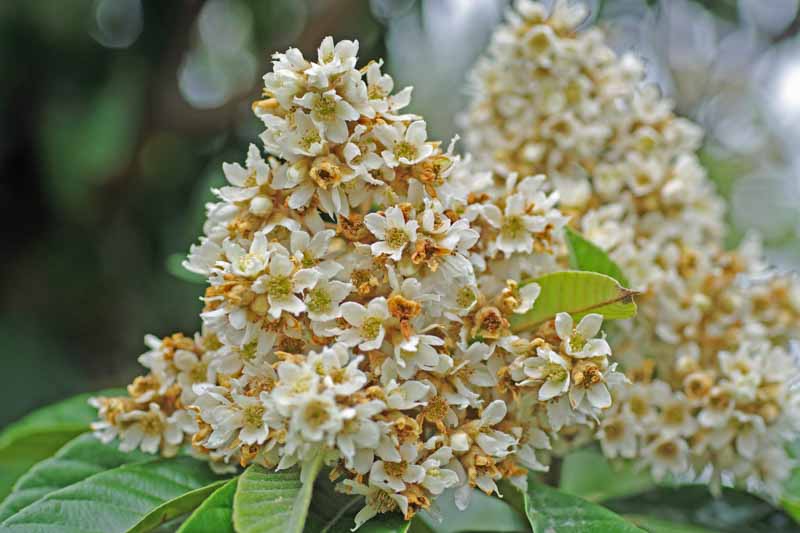
Loquat trees should be planted in late winter to early spring after the risk of frost has passed. This timing allows the tree to establish itself during the warmer months before facing its first winter.
Sunlight: Choose a sunny to partially shaded spot for your loquat tree, ensuring it receives at least 6 hours of sunlight daily.
Soil: The location should offer protection from strong winds and have fertile, well-draining soil to prevent root rot. Loquats do well in a range of soil types but prefer a slightly acidic to neutral pH.
Soil Preparation: Loosen the soil to a depth of 12-18 inches (30-45 cm) in an area about twice the diameter of the root ball. Amend the soil with compost or aged manure to improve fertility and drainage if necessary.
Planting Hole: Dig a hole as deep and twice as wide as the root ball of your loquat tree. This gives the roots room to spread and access nutrients.
Positioning: Gently remove the loquat tree from its container, being careful not to disturb the root ball too much. Place it in the center of the hole, ensuring that the top of the root ball is level with or slightly above the surrounding soil surface to allow for settling and water runoff.
Backfilling: Fill the hole with the removed soil, tamping down lightly as you go to eliminate air pockets. Water the tree well to settle the soil around the roots.
Watering: Keep the soil consistently moist but not waterlogged during the first growing season to support root establishment. Mulch around the base of the tree to retain soil moisture and regulate temperature, but keep the mulch a few inches away from the trunk to prevent rot.
Support: Stake the tree if necessary to protect it from strong winds until it is well-established.
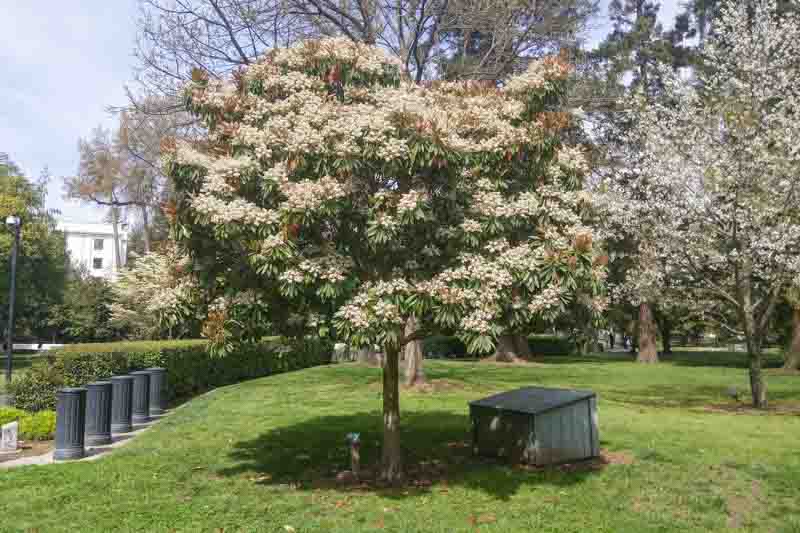
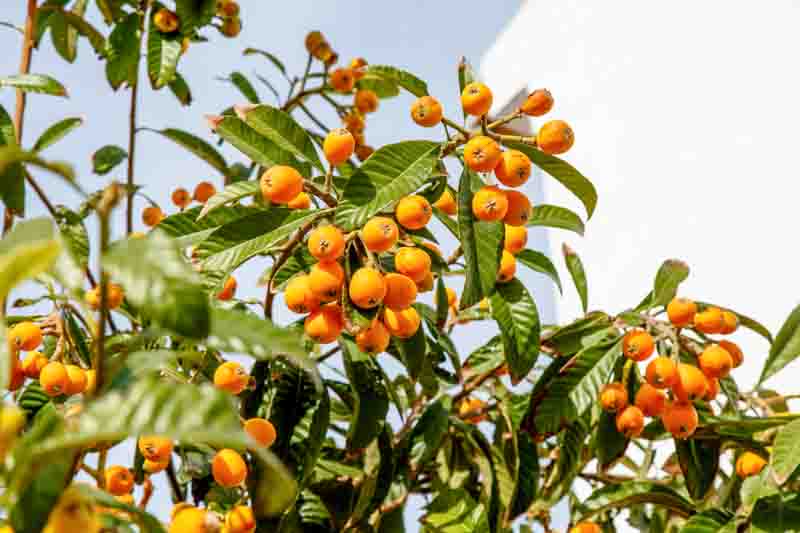
Collect Seeds: Use seeds from ripe loquats. Clean the seeds by removing any attached fruit flesh and rinse them under water.
Sowing: Plant seeds in a well-draining potting mix, about 1 inch deep (2.5 cm). Keep the soil moist but not waterlogged.
Germination: Seeds typically germinate within 30 days when kept at room temperature. However, seed-grown plants may not always reproduce the exact characteristics of the parent plant and can take longer to bear fruit.
Cutting Selection: Take 4-6 inch semi-hardwood cuttings (10-15 cm) from the current year’s growth in late summer.
Rooting Hormone: Dip the cut end in rooting hormone to encourage root development.
Planting: Plant the cuttings in a mixture of perlite and peat moss. Keep the substrate moist and provide high humidity and indirect light.
Root Development: Roots typically develop in a few weeks. Once established, the cuttings can be transplanted into individual pots.
Harvesting loquat fruit requires timely attention, as the fruits ripen quickly and are best when picked at the peak of their sweetness. Here are steps and tips to effectively harvest loquat fruits:
Timing: Loquat fruits typically ripen in late spring to early summer, depending on your climate. The exact timing can vary from year to year and by location. Fruits are ready for harvest when they turn a deep yellow or orange, feel slightly soft to the touch, and easily detach from the branch.
Visual and Tactile Clues: Look for uniform color development. Loquats should be fully colored, without green areas, indicating ripeness. Gently squeeze the fruit; ripe loquats will yield slightly under pressure.
Harvesting Technique: Gently twist or pull the fruit from the branch. If ripe, it should detach easily. You can also use pruning shears to cut the fruit stem, leaving a short stem attached to the fruit to reduce damage. It’s often helpful to harvest clusters of fruits together, especially if they are densely packed.
Handling: Handle loquats gently to avoid bruising, as they are quite delicate when ripe. Use a basket or container to collect the fruits, and avoid overloading to prevent crushing the fruits at the bottom.
Immediate Use or Storage: Loquats are best enjoyed fresh and soon after harvesting, as their shelf life is relatively short. If you need to store them, place the fruits in a plastic bag in the refrigerator, where they can last for about a week.
Utilization: Apart from eating fresh, loquats can be used in making jams, jellies, pies, and wines. They are also a tasty addition to salads and desserts.
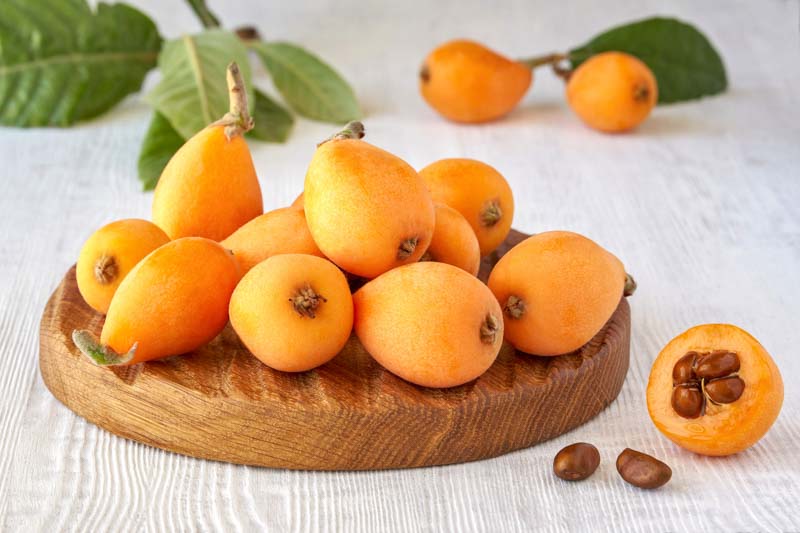
Loquat trees can encounter several pests, diseases, and common problems that affect their health and productivity.
Aphids: Aphids can cause leaf curl and stunted growth. They can be managed with insecticidal soaps or natural predators like ladybugs.
Scale insects: Scale can suck sap from leaves and stems, weakening the tree. Control measures include horticultural oil or insecticidal soap applications.
Fire blight: A bacterial disease that causes wilting and blackening of branches. Prune affected areas well below the damage and disinfect tools to prevent spread.
Leaf spot: Fungal diseases causing spots on leaves can be controlled by removing affected leaves and improving air circulation around the tree.
Root rot: Overwatering or poor drainage can lead to fungal diseases affecting the roots, leading to tree decline. Ensure well-draining soil and proper watering practices.
Canker: Canker causes sunken, dark lesions on branches and trunks, weakening and sometimes killing limbs. Prevent by avoiding tree wounds and pruning affected areas. Ensure proper sanitation by disinfecting tools and removing infected debris.
Anthracnose: Anthracnose manifests as dark, water-soaked lesions on fruits, leaves, and flowers, leading to decay. Prevent with fungicide treatments and by keeping the canopy open for air flow. Remove and destroy affected plant parts to reduce inoculum.
Sunburn: Young trees or newly exposed limbs can suffer from sunburn during hot, sunny weather. Provide shade or whitewash exposed limbs to protect them.
Nutritional Deficiencies: Yellowing leaves or poor fruiting can indicate a lack of nutrients. A balanced fertilizer can help address these deficiencies.
Frost Damage: Loquat trees are sensitive to frost, which can damage flowers and young fruits. Provide frost protection in colder climates.
Littering: Falling fruits can create a mess in areas with abundant fruit set, posing a challenge for maintenance and cleanliness.
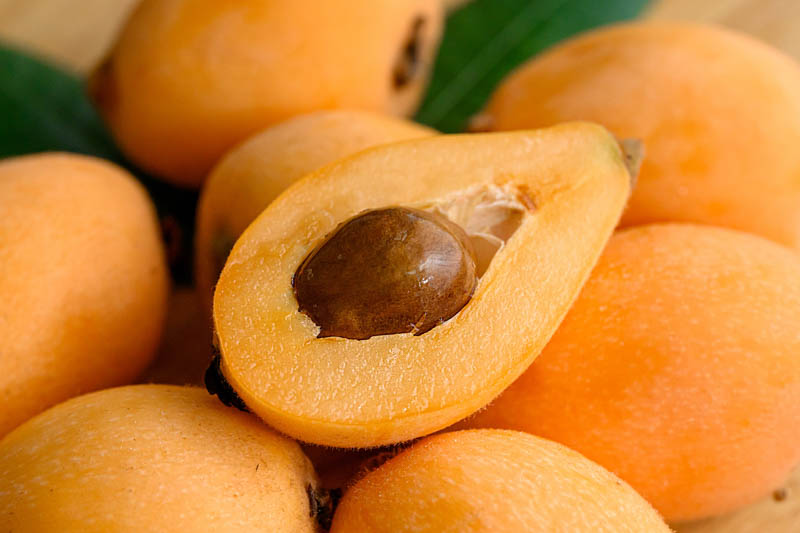
Loquat fruit is rich in vitamins A and C, dietary fiber, potassium, and antioxidants. These nutrients contribute to several health benefits, including boosting the immune system, improving digestive health, reducing the risk of certain cancers, and aiding in the maintenance of healthy skin and vision. The leaves of the loquat tree are also used in traditional medicine to make teas that can help soothe respiratory conditions.
Loquat fruit has a unique, sweet, and slightly tangy flavor, reminiscent of a blend of peach, citrus, and mild mango. The texture is similar to that of a peach or apricot, with juicy flesh that can range from firm to slightly soft, depending on ripeness.
Loquat fruit is generally safe for most people when consumed in food amounts. However, the seeds contain cyanogenic glycosides, substances that can release cyanide when digested. Eating large quantities of the seeds could be harmful. The leaves, while used medicinally, should be prepared properly to avoid toxicity.
Yes, the skin of the loquat fruit is edible. It is thin and can be easily eaten along with the flesh. However, some people prefer to peel it off due to texture or personal preference.
No, it is not safe to eat loquat seeds. They contain cyanogenic glycosides, which can be toxic if consumed in large amounts. Always remove and discard the seeds before eating the fruit.
To eat a loquat, first wash the fruit thoroughly. You can eat it whole, biting into it like an apple, skin and all, but avoid the seeds. Alternatively, you can cut the fruit in half and remove the seeds before consuming. Loquats can be eaten fresh, added to salads, desserts, jams, jellies, and even savory dishes for a sweet-tart flavor.
| Hardiness |
8 - 11 |
|---|---|
| Heat Zones |
8 - 11 |
| Climate Zones | 6, 7, 8, 9, 10, 11, 12, 13, 14, 15, 16, 17, 18, 19, 20, 21, 22, 23, 24, H1, H2 |
| Plant Type | Shrubs, Trees |
| Plant Family | Rosaceae |
| Common names | Loquat, Japanese Plum |
| Exposure | Full Sun, Partial Sun |
| Season of Interest |
Spring (Early, Mid, Late) Summer (Early, Mid, Late) Fall Winter |
| Height |
10' - 25' (3m - 7.6m) |
| Spread |
10' - 25' (3m - 7.6m) |
| Maintenance | Low |
| Water Needs | Average |
| Soil Type | Chalk, Clay, Loam, Sand |
| Soil pH | Acid, Alkaline, Neutral |
| Soil Drainage | Well-Drained |
| Characteristics | Plant of Merit, Showy, Evergreen, Fruit & Berries |
| Tolerance | Deer, Drought, Salt |
| Attracts | Birds |
| Garden Uses | Patio And Containers, Wall-Side Borders |
| Garden Styles | Coastal Garden, City and Courtyard, Mediterranean Garden |
| Hardiness |
8 - 11 |
|---|---|
| Heat Zones |
8 - 11 |
| Climate Zones | 6, 7, 8, 9, 10, 11, 12, 13, 14, 15, 16, 17, 18, 19, 20, 21, 22, 23, 24, H1, H2 |
| Plant Type | Shrubs, Trees |
| Plant Family | Rosaceae |
| Common names | Loquat, Japanese Plum |
| Exposure | Full Sun, Partial Sun |
| Season of Interest |
Spring (Early, Mid, Late) Summer (Early, Mid, Late) Fall Winter |
| Height |
10' - 25' (3m - 7.6m) |
| Spread |
10' - 25' (3m - 7.6m) |
| Maintenance | Low |
| Water Needs | Average |
| Soil Type | Chalk, Clay, Loam, Sand |
| Soil pH | Acid, Alkaline, Neutral |
| Soil Drainage | Well-Drained |
| Characteristics | Plant of Merit, Showy, Evergreen, Fruit & Berries |
| Tolerance | Deer, Drought, Salt |
| Attracts | Birds |
| Garden Uses | Patio And Containers, Wall-Side Borders |
| Garden Styles | Coastal Garden, City and Courtyard, Mediterranean Garden |
How many Eriobotrya japonica (Japanese Loquat) do I need for my garden?
| Plant | Quantity | |
|---|---|---|
| Eriobotrya japonica (Japanese Loquat) | N/A | Buy Plants |
Create a membership account to save your garden designs and to view them on any device.
Becoming a contributing member of Gardenia is easy and can be done in just a few minutes. If you provide us with your name, email address and the payment of a modest $25 annual membership fee, you will become a full member, enabling you to design and save up to 25 of your garden design ideas.
Join now and start creating your dream garden!
Create a membership account to save your garden designs and to view them on any device.
Becoming a contributing member of Gardenia is easy and can be done in just a few minutes. If you provide us with your name, email address and the payment of a modest $25 annual membership fee, you will become a full member, enabling you to design and save up to 25 of your garden design ideas.
Join now and start creating your dream garden!